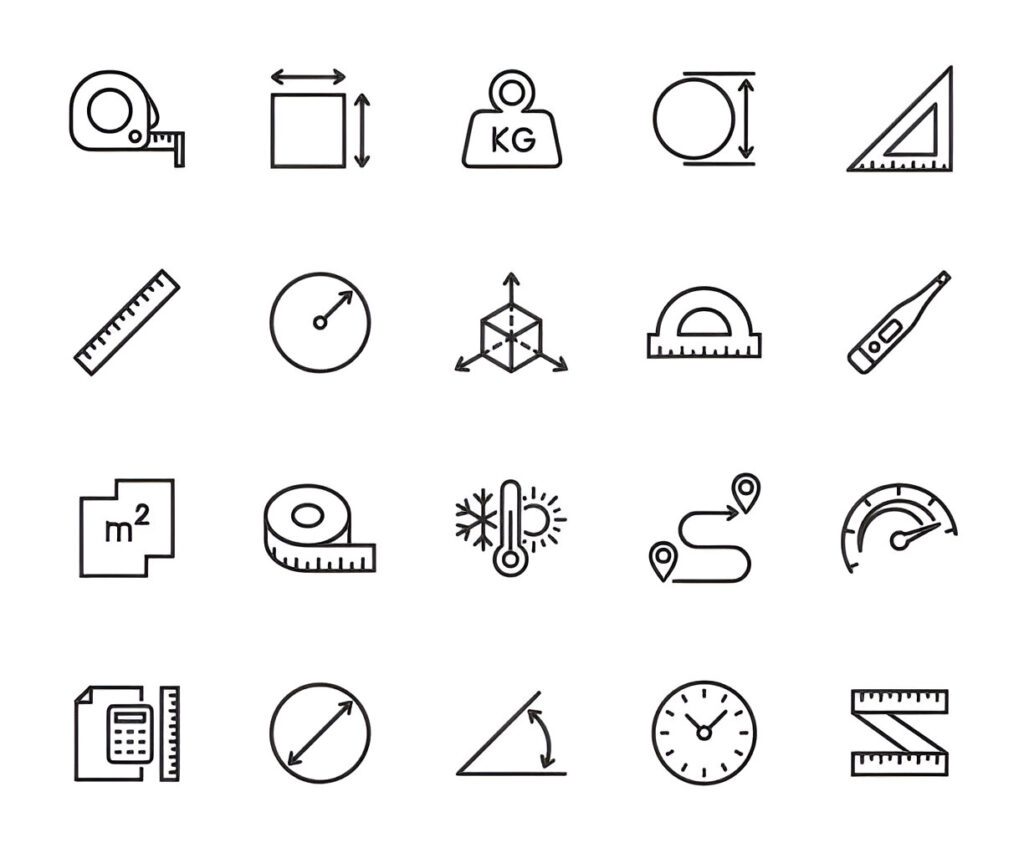This articles shows a brief history of measurements, it describes measurements based on Physics perspective. The article covers, the types of measurements, units, standard units and more. Ensure to read to the read and you will get everything you need to know about a brief history of measurements.
A BRIEF HISTORY OF MEASUREMENT
The earliest recorded systems of weights and measures originate in the 3rd or 4th millennium BC. Even the very earliest civilizations needed measurement for purposes of agriculture, construction and trade. Early standard units might only have applied to a single community or small region, with every area developing its own standards for lengths, areas, volumes and masses.
Often such systems were closely tied to one field of use, so that volume measures used, for example, for dry grains were unrelated to those for liquids, with neither bearing any particular relationship to units of length used for measuring cloth or land. With development of manufacturing technologies, and the growing importance of trade between communities and ultimately across the Earth, standardized weights and measures became critical.
Starting in the 18th century, modernized, simplified and uniform systems of weights and measures were developed, with the fundamental units defined by ever more precise methods in the science of metrology. The discovery and application of electricity was one factor motivating the development of standardized internationally applicable units.
The earliest known uniform systems of weights and measures seem all to have been created at some time in the 4th and 3rd millennia BC among the ancient peoples of Egypt, Mesopotamia and the Indus Valley, and perhaps also Elam (in Iran) as well.
Early Babylonian and Egyptian records and the Hebrew Bible indicate that length was first measured with the forearm, hand, or finger and that time was measured by the periods of the sun, moon, and other heavenly bodies.
When it was necessary to compare the capacities of containers such as gourds or clay or metal vessels, they were filled with plant seeds which were then counted to measure the volumes. When means for weighing were invented, seeds and stones served as standards. For instance, the carat, still used as a unit for gems, was derived from the carob seed.
SYSTEM INTERNATIONAL UNIT
The International System of Units, internationally known by the abbreviation SI (from French Système international d’unités), is the modern form of the metric system and the world’s most widely used system of measurement. Coordinated by the International Bureau of Weights and Measures (abbreviated BIPM from French: Bureau international des poids et mesures) it is the only system of measurement with official status in nearly every country in the world, employed in science, technology, industry, and everyday commerce.
| The seven SI base units | ||
| Symbol | Name | Quantity |
| s | second | time |
| m | metre | length |
| kg | kilogram | mass |
| A | ampere | electric current |
| K | kelvin | thermodynamic temperature |
| mol | mole | amount of substance |
| cd | candela | luminous intensity |
The SI comprises a coherent system of units of measurement starting with seven base units, which are the second (symbol s, the unit of time), metre (m, length), kilogram (kg, mass), ampere (A, electric current), kelvin (K, thermodynamic temperature), mole (mol, amount of substance), and candela (cd, luminous intensity).
The system can accommodate coherent units for an unlimited number of additional quantities. These are called coherent derived units, which can always be represented as products of powers of the base units. Twenty-two coherent derived units have been provided with special names and symbols.
The seven base units and the 22 coherent derived units with special names and symbols may be used in combination to express other coherent derived units. Since the sizes of coherent units will be convenient for only some applications and not for others, the SI provides twenty-four prefixes which, when added to the name and symbol of a coherent unit produce twenty-four additional (non-coherent) SI units for the same quantity; these non-coherent units are always decimal (i.e. power-of-ten) multiples and sub-multiples of the coherent unit.
The current way of defining the SI is a result of a decades-long move towards increasingly abstract and idealised formulation in which the realisations of the units are separated conceptually from the definitions. A consequence is that as science and technologies develop, new and superior realisations may be introduced without the need to redefine the unit.
One problem with artefacts is that they can be lost, damaged, or changed; another is that they introduce uncertainties that cannot be reduced by advancements in science and technology.
The original motivation for the development of the SI was the diversity of units that had sprung up within the centimetre–gram–second (CGS) systems (specifically the inconsistency between the systems of electrostatic units and electromagnetic units) and the lack of coordination between the various disciplines that used them.
The General Conference on Weights and Measures (French: Conférence générale des poids et mesures – CGPM), which was established by the Metre Convention of 1875, brought together many international organisations to establish the definitions and standards of a new system and to standardise the rules for writing and presenting measurements. The system was published in 1960 as a result of an initiative that began in 1948, and is based on the metre–kilogram–second system of units (MKS) combined with ideas from the development of the CGS system.

DERIVED UNITS
The system allows for an unlimited number of additional units, called derived units, which can always be represented as products of powers of the base units, possibly with a nontrivial numeric multiplier. When that multiplier is one, the unit is called a coherent derived unit. For example, the coherent derived SI unit unit of velocity is the metre per second, with the symbol m/s. The base and coherent derived units of the SI together form a coherent system of units (the set of coherent SI units).
A useful property of a coherent system is that when the numerical values of physical quantities are expressed in terms of the units of the system, then the equations between the numerical values have exactly the same form, including numerical factors, as the corresponding equations between the physical quantities.
Twenty-two coherent derived units have been provided with special names and symbols as shown in the table below. The radian and steradian have no base units but are treated as derived units for historical reasons.
| The 22 SI derived units with special names and symbols | ||||
| Name | Symbol | Quantity | In SI base units | In other SI units |
| radian[N 1] | rad | plane angle | m/m | 1 |
| steradian[N 1] | sr | solid angle | m2/m2 | 1 |
| hertz | Hz | frequency | s−1 | |
| newton | N | force, weight | kg⋅m⋅s−2 | |
| pascal | Pa | pressure, stress | kg⋅m−1⋅s−2 | N/m2 = J/m3 |
| joule | J | energy, work, heat | kg⋅m2⋅s−2 | N⋅m = Pa⋅m3 |
| watt | W | power, radiant flux | kg⋅m2⋅s−3 | J/s |
| coulomb | C | electric charge | s⋅A | |
| volt | V | electric potential, voltage, emf | kg⋅m2⋅s−3⋅A−1 | W/A = J/C |
| farad | F | capacitance | kg−1⋅m−2⋅s4⋅A2 | C/V = C2/J |
| ohm | Ω | resistance, impedance, reactance | kg⋅m2⋅s−3⋅A−2 | V/A = J⋅s/C2 |
| siemens | S | electrical conductance | kg−1⋅m−2⋅s3⋅A2 | Ω−1 |
| weber | Wb | magnetic flux | kg⋅m2⋅s−2⋅A−1 | V⋅s |
| tesla | T | magnetic flux density | kg⋅s−2⋅A−1 | Wb/m2 |
| henry | H | inductance | kg⋅m2⋅s−2⋅A−2 | Wb/A |
| degree Celsius | °C | temperature relative to 273.15 K | K | |
| lumen | lm | luminous flux | cd⋅m2/m2 | cd⋅sr |
| lux | lx | illuminance | cd⋅m2/m4 | lm/m2 = cd⋅sr⋅m−2 |
| becquerel | Bq | activity referred to a radionuclide (decays per unit time) | s−1 | |
| gray | Gy | absorbed dose (of ionising radiation) | m2⋅s−2 | J/kg |
| sievert | Sv | equivalent dose (of ionising radiation) | m2⋅s−2 | J/kg |
| katal | kat | catalytic activity | mol⋅s−1 | |
The derived units in the SI are formed by powers, products, or quotients of the base units and are potentially unlimited in number.
Derived units apply to some derived quantities, which may by definition be expressed in terms of base quantities, and thus are not independent; for example, electrical conductance is the inverse of electrical resistance, with the consequence that the siemens is the inverse of the ohm, and similarly, the ohm and siemens can be replaced with a ratio of an ampere and a volt, because those quantities bear a defined relationship to each other.
Other useful derived quantities can be specified in terms of the SI base and derived units that have no named units in the SI, such as acceleration, which has the SI unit m/s2.
A combination of base and derived units may be used to express a derived unit. For example, the SI unit of force is the newton (N), the SI unit of pressure is the pascal (Pa) – and the pascal can be defined as one newton per square metre (N/m2).
STANDARD UNIT
A standard unit of measurement is a quantifiable language that describes the magnitude of the quantity. It helps to understand the association of the object with the measurement.
There are many systems and units in place for measuring different quantities like length, area, mass, volume and other things. For example, an acre is a common way of representing area measurement in India.
One acre is around 4046 square metres, according to the metric system. Similarly, the temperature is measured in degree celsius, and the same unit of measurement cannot be used to measure the length of a rod. Each quantity has to be measured in its own way. The magnitude and the measurement vary along with the quantity. Hence the need for the units of measurement for each quantity arises.
Standard units are used in measurement for more accuracy. The measurement should be the same for all. As there needs to be uniformity in the measurement, we must have a common set of units in measurement. These are called standard units. The standard unit is different for different quantities.
The standard unit of measurement is a value that is fixed and cannot be changed. It is needed to have uniformity in measurement. The measurement is measured as feet, inches, and pounds in the United States and meters, centimetres, and kilograms in the metric system.
REFERENCES
Buchholz, K. (2019). “Only Three Countries in the World (Officially) Still Use the Imperial System”. Statista. Archived from the original on February 13, 2020. Retrieved April 21, 2020.
International Bureau of Weights and Measures (2022), The International System of Units (SI) (9th ed.), vol. 2
Jefferson, T. (2000). “Plan for Establishing Uniformity in the Coinage, Weights, and Measures of the United States Communicated to the House of Representatives. New York.
Linklater, A. (2002). Measuring America: How an Untamed Wilderness Shaped the United States and Fulfilled the Promise of Democracy. Walker & Co..
Materese, R. (2018). “Historic Vote Ties Kilogram and Other Units to Natural Constants”. NIST. Retrieved 16 November 2018.
O’Connor, J. J. and Robertson, E. F. (2004), “History of measurement”, MacTutor History of Mathematics Archive, University of St Andrews
For more of this kind of article check here
Share this articles to your friends and colleagues using the social media icons below
